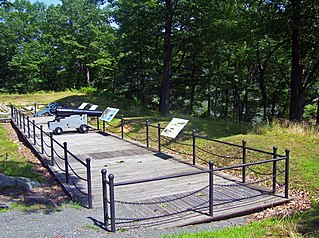
Fort Montgomery was a fortification built on the west bank of the Hudson River in Highlands, New York by the Continental Army during the American Revolution. Erected in 1776, Fort Montgomery was one of the first major investments by the Americans in strategic construction projects.
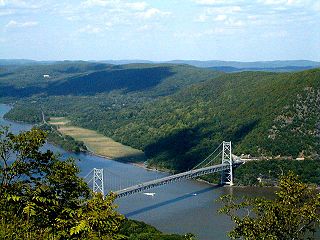
The Hudson River is a 315-mile (507 km) river that flows from north to south primarily through eastern New York in the United States. It originates in the Adirondack Mountains of Upstate New York and flows southward through the Hudson Valley to the Upper New York Bay between New York City and Jersey City, eventually draining into the Atlantic Ocean at New York Harbor. The river serves as a political boundary between the states of New Jersey and New York at its southern end. Farther north, it marks local boundaries between several New York counties. The lower half of the river is a tidal estuary, deeper than the body of water into which it flows, occupying the Hudson Fjord, an inlet which formed during the most recent period of North American glaciation, estimated at 26,000 to 13,300 years ago. Even as far north as the city of Troy, the flow of the river changes direction with the tides.

Dutchess County is a county in the U.S. state of New York. As of the 2020 census, the population was 295,911. The county seat is the city of Poughkeepsie. The county was created in 1683, one of New York's first twelve counties, and later organized in 1713. It is located in the Mid-Hudson Region of the Hudson Valley, north of New York City.

Saratoga County is a county in the U.S. state of New York, and is the fastest-growing county in Upstate New York. As of the 2020 U.S. Census, the county's population was enumerated at 235,509, representing a 7.2% increase from the 2010 population of 219,607, representing one of the fastest growth rates in the northeastern United States. The county seat is Ballston Spa. Saratoga County is included in the Capital District, encompassing the Albany-Schenectady-Troy, New York Metropolitan Statistical Area.

Hyde Park is a town in Dutchess County, New York, United States, bordering the Hudson River north of Poughkeepsie. Within the town are the hamlets of Hyde Park, East Park, Staatsburg, and Haviland. Hyde Park is known as the hometown of Franklin D. Roosevelt, the 32nd president of the United States. His house there, now the Home of Franklin D. Roosevelt National Historic Site, is listed on the U.S. National Register of Historic Places, as are the homes of Eleanor Roosevelt, Isaac Roosevelt, and Frederick William Vanderbilt, along with Haviland Middle School.

The Hudson Valley comprises the valley of the Hudson River and its adjacent communities in the Upstate region of the U.S. state of New York. The region stretches from the Capital District including Albany and Troy south to Yonkers in Westchester County, bordering New York City.
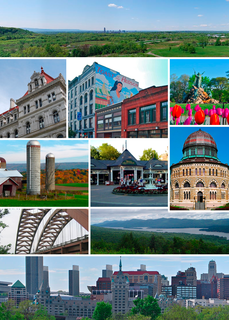
The Capital District, also known as the Capital Region, is the metropolitan area surrounding Albany, the capital of the U.S. state of New York. In the 21st century, the Capital District emerged as a major anchor of Tech Valley, the moniker describing the technologically focused region of eastern New York State. The Capital District was first settled by the Dutch in the early 17th century and came under English control in 1664. Albany has been the permanent capital of the state of New York since 1797. The Capital District is notable for many historical events that predate the independence of the United States, including the Albany Plan of Union and The Battles of Saratoga.
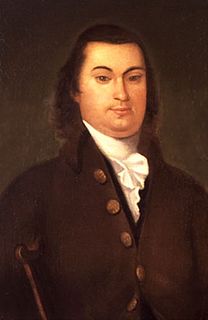
Robert Robert Livingston, also called The Judge, was a prominent colonial American politician, and a leading Whig in New York in the years leading up to the American Revolution.

The Great Sacandaga Lake is a large lake situated in the Adirondack Park in northern New York in the United States. The lake has a surface area of about 41.7 square miles (108 km2) at capacity, and the length is about 29 miles (47 km). The word Sacandaga means "Land of the Waving Grass" in the local native language. The lake is located in the northern parts of Fulton County and Saratoga County near the southern border of the Adirondack Park. A small portion also extends northward into southern Hamilton County. The broader, south end of the lake is northeast of the City of Johnstown and the City of Gloversville. Great Sacandaga Lake is a reservoir created by damming the Sacandaga River. The primary purpose for the creation of the reservoir was to control flooding on the Hudson River and the Sacandaga River, floods which had a historically significant impact on the surrounding communities.

In the United States, A National Heritage Area (NHA) is a site designated by Act of Congress, intended to encourage historic preservation of the area and an appreciation of the history and heritage of the site. There are currently 55 NHAs, some of which use variations of the title, such as National Heritage Corridor.
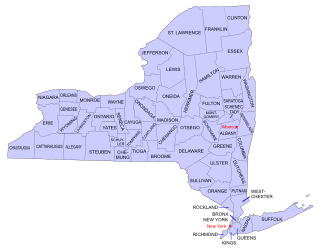
There are over 6,000 properties and districts listed on the National Register of Historic Places in New York State. Some are listed within each one of the 62 counties in New York State. Of these, 264 are further designated as National Historic Landmarks.
U.S. Route 9 (US 9) is a part of the U.S. Highway System that runs from Laurel, Delaware, to Champlain, New York. In New York, US 9 extends 324.72 miles (522.59 km) from the George Washington Bridge in Manhattan to an interchange with Interstate 87 (I-87) just south of the Canada–United States border in the town of Champlain. US 9 is the longest north–south U.S. Highway in New York; additionally, the portion of US 9 in New York accounts for more than half of the highway's total length.

The Delaware & Lehigh Canal National and State Heritage Corridor (D&L) is a 165-mile (266 km) National Heritage Area in eastern Pennsylvania in the United States. It stretches from north to south, across five counties and over one hundred municipalities. It follows the historic routes of the Lehigh and Susquehanna Railroad, Lehigh Valley Railroad, the Lehigh Navigation, Lehigh Canal, and the Delaware Canal, from Bristol to Wilkes-Barre in the northeastern part of the state. The backbone of the Corridor is the 165-mile (266 km) D&L Trail. The Corridor's mission is to preserve heritage and conserve green space for public use in Bucks, Northampton, Lehigh, Carbon, and Luzerne counties in Pennsylvania. It also operates Hugh Moore Historical Park & Museums, which includes the National Canal Museum.
The Crossroads of the American Revolution National Heritage Area is a federally designated National Heritage Area encompassing portions of fourteen counties in New Jersey that were the scene of significant actions in the American Revolutionary War in late 1776 through 1778. The designated area covers the Delaware and Hudson valleys in New Jersey and the central portion of the state between the valleys where the Continental Army fought forces under British command. The National Heritage Area includes Morristown National Historical Park and sites associated with the Battle of Monmouth as well as Princeton, New Jersey, the meeting place of the Continental Congress when peace was declared in 1783.
Historic preservation in New York is activity undertaken to conserve forests, buildings, ships, sacred Indian burial grounds, water purity and other objects of cultural importance in New York in ways that allow them to communicate meaningfully about past practices, events, and people. Governmental programs for historic preservation range from Federal ownership and active operation of sites to grants and subsidies provided by state government, municipal support of museums and interpretative displays. Nonprofit programs include activities of statewide and local historical associations and museums, and activities of historical societies and museums at the national level. Quasi-governmental organizations, such as the New York State Thruway Authority and Thousand Islands Bridge Authority, play a role as well. Private endeavors, such as investment and other choices made by private landowners to conserve historical features of their properties, are significant but less visible and include groups such as the Historic Districts Council, The New York Landmarks Conservancy and the Preservation League of New York State. During the reconstruction of the World Trade Center site in July 2010, a team of archaeologists discovered a 32-foot-long boat. The craft was at least 200 years old, dating from a time when the Hudson River was partly filled with trash and debris because of a rapidly expanding lower Manhattan.

Culture in New York's Capital District, also known as the Albany metropolitan area, stretches back to the 17th century. The area has seen prominent historical events, interesting artistic creations, and unique contributions to the culture of the United States. The largest city in the area, Albany, consistently ranks high on lists of top cities/metro areas for culture, such as being 23rd in the book Cities Ranked & Rated. The Albany-Schenectady-Troy metro area ranked 12th among large metro areas, and Glens Falls ranked 12th among the small metro areas, in Sperling's Best Places, and Expansion Management gave the Albany-Schenectady-Troy area five Stars, its highest ranking, for quality of life features.
The Hudson River Valley Institute is a center for regional studies of the Hudson Valley of New York State. It is an academic extension of Marist College in Poughkeepsie, New York. The academic institution provides internships for Marist History majors and contributes to local happenings, such as the Walkway Over the Hudson and the Mount Beacon Inclined Railway Restoration Society. Furthermore, they oversee Marist's publication of the Hudson River Valley Review, a journal of regional studies featuring historical research on the Hudson River Valley.
The Champlain Valley National Heritage Area is a federally designated National Heritage Area encompassing eleven counties in New York and Vermont surrounding Lake Champlain. The heritage area designation recognizes the area's historical and scenic significance. The region was a strategic corridor between the Hudson Valley of the United States and the Richelieu Valley of Quebec during the American Revolution in the late 18th century, and saw considerable military action during the War of 1812. During the American Civil War the valley was a part of the Underground Railroad network.

Schuylkill River National and State Heritage Area is a federally designated National Heritage Area in the valley of the Schuylkill River in southeastern Pennsylvania. The heritage area extends from Pottsville to Philadelphia through Schuylkill, Berks, Chester, Montgomery and Philadelphia counties. The national heritage area interprets and promotes the river's history during the American Revolution and the Industrial Revolution, as well as its natural environment and its recreational use.

The Maritje Kill is a tributary of the Hudson River in Hyde Park, New York. Its source is three miles northeast of the village of Hyde Park, and it enters the Hudson at the Hyde Park campus of the Culinary Institute of America (CIA). The river's name uses an old Dutch version of the given name Marietje, meaning "little Mary". It is one of two major waterways in Hyde Park, and flows north to south through the town.















